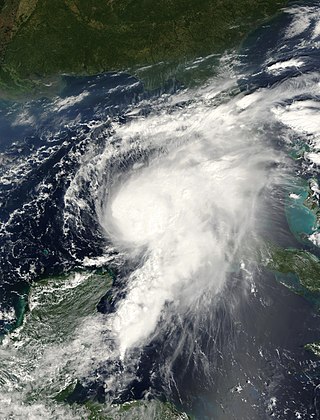
The Florida Keys are a coral cay archipelago off the southern coast of Florida, forming the southernmost part of the continental United States. They begin at the southeastern coast of the Florida peninsula, about 15 miles (24 km) south of Miami, and extend in a gentle arc south-southwest and then westward to Key West, the westernmost of the inhabited islands, and on to the uninhabited Dry Tortugas. The islands lie along the Florida Straits, dividing the Atlantic Ocean to the east from the Gulf of Mexico to the northwest, and defining one edge of Florida Bay. At the nearest point, the southern part of Key West is just 93 miles (150 km) from Cuba. The Keys are between about 24.3 and 25.5 degrees North latitude.

Hurricane Gordon caused minor damage in the Eastern United States. The seventh named storm and fourth hurricane of the 2000 Atlantic hurricane season, Gordon developed in the extreme western Caribbean Sea from a tropical wave on September 14. Shortly thereafter, the depression moved inland over the Yucatán Peninsula and later emerged into the Gulf of Mexico on September 15. The depression began to quickly organize, and by early on September 16, it was upgraded to Tropical Storm Gordon. After becoming a tropical storm, Gordon continued to intensify and was reclassified as a hurricane about 24 hours later; eventually, the storm peaked as an 80 mph (130 km/h) Category 1 hurricane. However, southwesterly upper-level winds caused Gordon to weaken as it approached land, and it was downgraded to a tropical storm by late on September 17. At 0300 UTC on September 18, Gordon made landfall near Cedar Key, Florida as a strong tropical storm. After moving inland, Gordon rapidly weakened and had deteriorated to tropical depression status by nine hours later. Later that day, Gordon merged with a frontal boundary while centered over Georgia.

Ethmia quadrillella is a moth belonging to the family Depressariidae, subfamily Ethmiinae.

Ethmia chrysopyga is a moth of the family Depressariidae. It is found in southern Europe and Anatolia up to the Caucasus region.

Ethmia terminella is a moth of the family Depressariidae. It was described by Thomas Bainbrigge Fletcher in 1838 and is found in Europe.

Ethmia delliella, the ladder-backed ethmia moth, is a moth in the family Depressariidae. It is found from the Gulf region of Texas and Mexico to the west coastal plain of Mexico, Chiapas, El Salvador and Costa Rica.
Ethmia abraxasella is a moth in the family Depressariidae. It is found in Jamaica, Haiti, the Dominican Republic, Puerto Rico, Cuba and the Bahamas. It has also been recorded from southern Florida in the United States.
Ethmia submissa is a moth in the family Depressariidae. It is found in Cuba, Jamaica and Puerto Rico. It has also been recorded from southern Florida in the United States.
Ethmia notatella is a moth in the family Depressariidae. It is found in the Florida Keys, the Bahamas, Hispaniola, Puerto Rico and the Lesser Antilles (Curacao).
Ethmia wellingi is a moth in the family Depressariidae. It is found in Mexico. Records from Costa Rica refer to Ethmia stephenrumseyi.
Ethmia confusella is a moth in the family Depressariidae. It is found from the Florida Keys and Bahamas, through the Greater Antilles to the Yucatan Peninsula, and through the Lesser Antilles to Trinidad.
Ethmia julia is a moth in the family Depressariidae. It is found in Puerto Rico and the Florida Keys.
Ethmia farrella is a moth in the family Depressariidae. It is found in Jamaica and the Florida Keys.

Ethmia stephenrumseyi is a moth in the family Depressariidae. It is found in Costa Rica, where it has been recorded from most of the country at altitudes ranging from 660 to 1,250 meters.

Ethmia lesliesaulae is a moth in the family Depressariidae. It is found in Costa Rica, where it has been recorded from both sides of the Cordillera Volcánica de Guanacaste al altitudes ranging from 300 to 645 meters. The habitat consists of rain forests.

Ethmia hendersonorum is a moth in the family Depressariidae. It is found in Costa Rica, where it has been recorded from the Caribbean slope at an altitude of 600 meters (2,000 ft). The habitat consists of dry forests.

Ethmia randyjonesi is a moth in the family Depressariidae. It is found in Costa Rica, where it has been recorded from the Cordillera Volcánica de Guanacaste, Tilarán and Cordillera Volcánica Central at altitudes ranging from 500 to 1,200 meters. The habitat consists of rain forests.

Ethmia tilneyorum is a moth in the family Depressariidae. It is found in Costa Rica, where it has been recorded from the Pacific slope of the Cordillera Volcánica de Guanacaste and on the Península de Nicoya at altitudes between 50 and 160 meters. Its habitat consists of dry forests.

Ethmia randycurtisi is a moth in the family Depressariidae. It is found in Costa Rica, where it has been recorded from the Cordillera Volcánica de Tilarán and Cordillera Volcánica Central al altitudes ranging from 1,200 to 1,600 meters.











